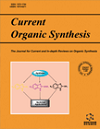-
oa Editorial [The Trifluoromethyl Group in Organic Synthesis: Recent Developments (Guest Editor: Simon E. Lopez)]
- Source: Current Organic Synthesis, Volume 7, Issue 5, Oct 2010, p. 402 - 402
-
- 01 Oct 2010
- Previous Article
- Table of Contents
- Next Article
Abstract
From the organic synthesis point of view, major reviews concerning the uses and applications of the trifluoromethyl group in chemistry appeared in the 90's by Kiselyov [1] and McClinton [2]. Despite fluorine atoms are extremely rare in natural compounds, they have a valuable importance in drug synthesis and agrochemicals. Particularly, the trifluoromethyl group is very common in drug compounds (i.e marketed pharmaceutical compounds such as the anti-depressant fluoxetine 1 (Prozac), the COX-2 inhibitor celecoxib 2 (Celebrex), the antimalarial drug mefloquine 3 and the HIV protease inhibitor tipranavir 4 (Aptivus)). Trifluoromethyl compounds are also valuable intermediates in synthesis, for the preparation of pharmaceuticals, agrochemicals and ionic liquids. Since Moisson's elemental F2 discovery in 1886, fluorine had attracted the attention of chemists due to its properties as a reagent for the direct preparation of several organic and inorganic compounds; however, its extreme reactivity limits its widespread laboratory use. The 1970's decade marked the development of new safer and selective fluorinating agents, compatible with ordinary laboratory equipment, and thus permitted a growing field for the fluorination of organic key molecules. Recent developments in the synthetic methodology toward trifluoromethyl containing organic molecules have given rise to a great interest in the scientific community, from both academy and industry. This special Issue of Current Organic Synthesis covers some interesting aspects of the trifluoromethyl group in organic synthesis, such as the trifluomethylation of carbonyl compounds, stereoselective construction of an assymetric center containing a trifluoromethyl group, preparation of trifluorometyl-substituted fused bicycled-heterocycles and the trifluoacetylation of organic molecules, including its application for the preparation of trifluomethyl heterocycles.


